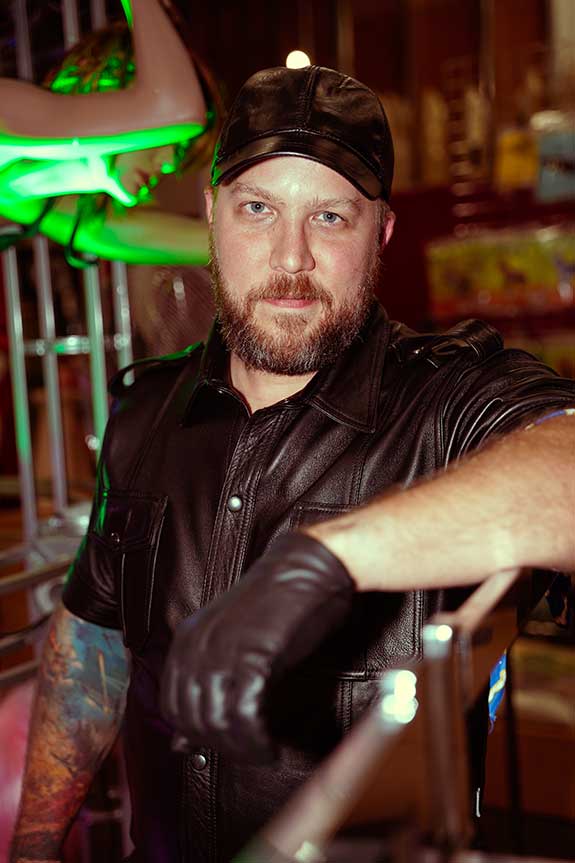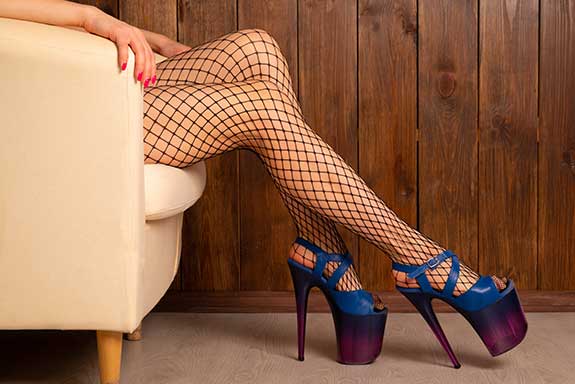Leather and the Las Vegas Community
By Topher “Bamm” Orzech
The history of the leather community is as varied and, in some ways, as complicated as the LGBTQ+ community itself, even as a subset of the BDSM world. I spoke a bit about this last fall at The Las Vegas PRIDE Festival on the PROUD & Kinky stage when I gave a brief history (I called it a “Leather TED Talk”) and found that many of our community are unaware of where we came from. Another component of this history that I have not yet had the chance to talk about is how our wonderful city fits into all this.

To Las Vegas, I might be somewhat of an outsider for those of you who grew up here, since I come from the northeast United States, and I’ve only been here 5 years or so. One thing my experience in Leather has taught me, though, is that a community is only as good as those who work towards a better future. In many ways, this means those who volunteer to do so, whether it be to lead an organization like Las Vegas PRIDE, or, in the case of the leather community, participate in events, fundraisers, and yes: leather titles. When I accepted the role of Mr. Las Vegas Leather last summer, I wanted to ensure that I helped this community grow. I’ve also been continuously fascinated by how different our leather community is from other cities I’ve lived in (Boston, San Francisco, and Austin, where I was stationed during my military time).
For those who were unable to hear the “Leather TED Talk,” the leather community and the kink community alike trace their roots back much more than a few decades, even back to the ancient world. I’m going to focus on the modern leather world, however, which bears a likeness to modern history in that it completely changed following the Second World War. This event shattered what we knew at the time, changing the ways we lived and viewed the world, and this can plainly be seen in art and music from the post-war era. We also see this ingrained in leather culture.
Many gay men who had been drafted and who served overseas came home with a profoundly different view of the world and, in some ways, longed for the structure they had experienced in the military. These men were the pioneers of the leather subculture (of BDSM), especially in big cities like NYC, Chicago or San Francisco. Others came back craving the adrenaline and opted to live a sort of “outlaw” lifestyle, growing into what became the biker community, especially as seen in the southwest. As many know, Bikers often wear Leather because of its strength and ability to protect a rider while maintaining flexibility. Over the years, this grew into a stylized uniform for leathermen to wear, and it had many similarities to the biker and military communities. This, in some ways, bears a resemblance to the 1953 film The Wild One, starring Marlon Brando (go hop on Google and look it up), and while it might not have shaped the culture much, it certainly was a good look.
Over the next twenty years or so, taking us through the late 1950s and 60s, gay bars started to be more common, with the first being the Gold Coast, opening in Chicago in 1958, and others like Tool Box operating in San Francisco in 1962. While very preliminary, these spaces were safe havens for leathermen, and bars all over started to appear, even in Europe (especially Germany). Leather bars often saw plenty of “action” even if it was frowned upon (I’ve often read “frowned upon but tolerated” by bar owners), but this mainly applies to the leather subset of the overall BDSM community. Private BDSM parties were typically held in secret, at private residences, especially since bars were subject to raids and threatened to expose members of the community. It was this sort of secrecy that resulted in aspects of the community such as the hanky code, that is, putting a colored hanky in either your left or right back pocket to clue others in as to what you’re into (I wear navy blue and gray hankies in my left pocket as a nod to this tradition when I’m in formal wear). Leather uniforms also increased in popularity around this time, which led to some events and bars requiring a leather uniform to attend.

Photo by Kristopher Minnich
The time period between WWII and the 1960s saw the development of what many nowadays refer to as the “Old Guard,” a term whose use is sometimes frowned upon or referred to as a myth. The strictness mentioned above is usually what is being referred to, but from talking to friends (albeit here in now 2025), I’ve started to accumulate a variety of different perceptions on this topic. Take the Muir Cap, for example: this common piece of leather clothing, closely resembling a biker cap or even a military dress uniform wheel cap, was in some circles only ever “given” to members once proving their status as a Dom (or master/Sir). Nowadays, men often just buy one since these traditions have died off or barely exist. Others still insist that this is purely a myth. Another not-so-good connotation with the OG is the idea (and, in many cases, fact) that consent was an afterthought for many Doms or even just those in attendance at leather bars and events. As I’m sure everyone nowadays would agree, consent is necessary (I often say consent is sexy). While there isn’t a “new guard” in any official capacity, the growth through the 80s and to the modern day represents this new mindset, especially in the previous 15 years. My earliest experiences in Leather were around 2011, and it was quite a different environment even then.
Regardless of tradition, the 70s and 80s saw the first leather titles, with again the Gold Coast holding its first competition in 1972, which many might know as having grown into the International Mr. Leather (IML) contest in 1979, still held annually in Chicago. Many other events followed, such as Mr. Mid-Atlantic Leather (MAL), which I go to yearly and quite enjoy. These events have grown into large-scale weekends, with thousands of attendees, even if most come to catch up with friends, experience new kinks, visit demos, and purchase Leather of all varieties rather than participate in the contest. The tradition of titleholders is not just one of being able to show it off but rather a responsibility to continue growing, contributing, and nurturing the leather community in your own backyard.
One key aspect of the leather community that sometimes gets ignored, or to which some express resistance, is inclusivity. The leather community as we know it might have started with gay veterans, which is, of course, a very personal connection for me, but very early on, the communities of San Francisco and others began to include women. One of the most well-known examples of this was Dykes on Bikes, which started in 1976 and is still around today. Leather bars that were initially closed off to women patrons began to allow all genders to attend, even if certain spaces had a preference or abundance of men only. Our own leather events here in Las Vegas have an abundance of both men and women and are a joint venture of the two prominent leather clubs in town: The Las Vegas boys of Leather and the Leather Uniform Club of Las Vegas. One of the chief concepts of today’s leather world seems to be that there is no wrong way to participate in the community. Some friends I know wear full leather outfits and are rather vanilla otherwise. Others have very few pieces of actual Leather to wear but have a full dungeon in their home; Leather is flexible and strong, and the community is big enough to embrace and include us all.

Photo by Kristopher Minnich
Another huge part of the history of leather communities is that leather clubs tend to give back to the community, whether it is through putting on events or through direct fundraising, which is something both VboL and LUC participate in readily. This dates back to the AIDS pandemic and its rise in the 1980s. Leather clubs, both men and women alike, donated to the cause, especially lesbians when so many gay men had fallen ill. This sort of profound commitment to the community is immensely important and makes me extremely happy that I have the privilege of participating in this. I’m happy to watch our leather clubs continue to support many local charities, especially those directly related to the LGBTQ+ community.
With all of this being said and a very brief history (believe me, I could ramble on about so many different sub-areas of the leather community, such as pups and handlers), where does this leave our own Las Vegas leather community? We are a somewhat oddly positioned and proportioned group, being spread out over a massive city that, at any given moment, is home to tens of thousands of tourists and caters directly to them rather than the locals. In many ways, the leather community here is sparse and exists on the fringe, but this is also something that makes our city unique. It is also a challenge since many are unaware of their own community.
As the current Vice President of the Las Vegas boys of Leather, I try to be approachable and conversational about all this since the community is constantly growing and changing. This is also why I’ve enjoyed this year as Mr. Las Vegas Leather; I want to see others participate, continue to make more happen, and encourage our community to grow. This year has also shown me that this is a team effort and that every person has something they can contribute. From asking around and talking with others at our local leather events, most were completely unaware we even had leather titles and were happy to see them. I would love to see this community grow to the point of having our own traditions and contests as we continue to foster our leather culture and find our own voice in the leather world.

Photo by Ali Vesey
A huge part of being a leather titleholder is not just being able to lead or to be a voice in the community but rather to weigh in and share your own experience and journey to help inspire others. Having come from Mid-Atlantic Leather last weekend, I truly enjoyed listening to their outgoing Mr. MAL speak on his experience in the world, both the good and the bad. Whether or not we wear leather all the time, we share this world with each other, and we all see a different view of it. I’ve seen plenty of both good and bad, and this is right within other people of Leather. Being a veteran has also shaped the way I wear leather, especially because of the clothing’s roots and traditions, and I’m excited by the fact that we, in 2025, get to share this community with so many others; Leather is strong yet flexible, it stands the test of time, and it represents the LGBTQ+ community itself because it is big enough to embrace us all. I’m excited to continue watching the Las Vegas leather community grow, and I encourage you to make it your own.
This article was originally published in the second issue of PROUD & Kinky Magazine. You may read it in its original format here.






